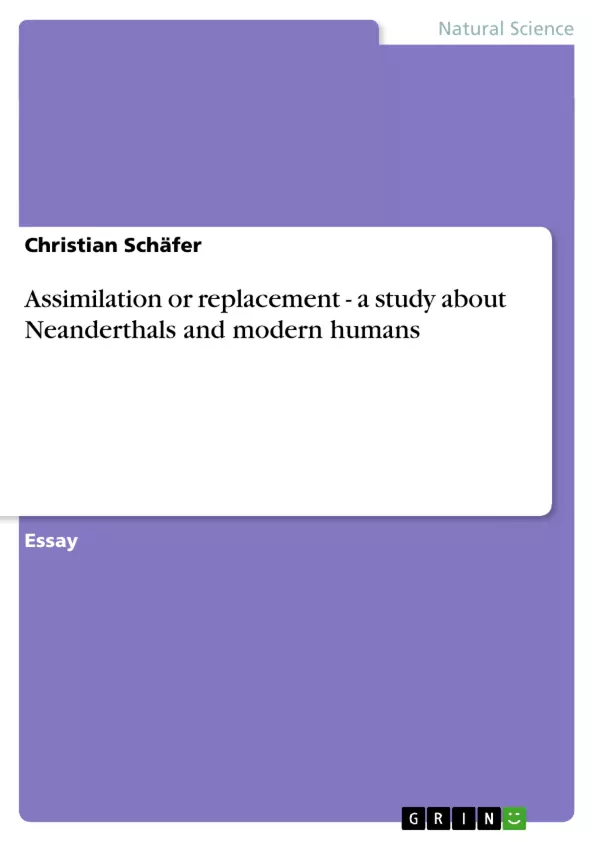The Neanderthals lived in Europe and the Near East for at least 250,000 years and they outdared several climate changes. They were capable of surviving in a harsh, cold environment and were well adapted to it – cultural and morphological. Thus, the Neanderthals have been proven to be a successful human kind. But why then did they disappear so quickly and without a trace just between 40,000 and 28,000 yr BP (= years before present) [8]?
One possible answer is that modern humans starting to invade the Near East and Europe out of Africa 45,000 to 40,000 yr BP have outcompeted them, due to higher cultural and mental abilities, using the resources in a more efficient way than the Neanderthals. But is this really true? Have modern humans really had higher abilities? Did they admix with the local Neanderthal populations, integrating the native genes in their gene pool? Or did modern humans not interbreed with them?
And – the big question: were Neanderthals and anatomically modern humans distinct species or just local variants of the same species?
To bring more light into this scenario, these questions will be answered in the following chapters using genetic, morphological and simulation-data that has been brought up by several researchers over the last years.
Answering these fundamental questions also lies in the range of basic needs of human mind: we all want to know where we come from, who was our ancestor and who was it not. To realize which strange ways evolution sometimes takes and to determine what really happened is for sure an exciting thing, and that is exactly what researchers do when they trace human evolution back to the point when Neanderthals and modern humans met in Europe during the last ice age. Only one of them should survive this meeting, and to determine why and how this happened I will start with the description and comparison of the two main characters.
Inhaltsverzeichnis (Table of Contents)
- Introduction
- Description and comparison of the two main characters
- Morphology
- Cultural abilities
- Dispearsal areas
- Time span of existence
- Who was the last common ancestor of Neanderthals and modern humans and where did he live?
- Genetic evidence
- Fossil record
- Description of the main issue
- Molecular/genetic research
- Presentation of the four hypothesis concerning the transition from H. ergaster/erectus to Homo sapiens
- Integration of “assimilation” and “replacement” into these models
- mtDNA comparison of Neanderthal fossils, modern human remains and current modern humans
- Archaeological and palaeontological research
- Comparison of the morphology of skeletal remains of different ages and parts of the world
- Comparison of the cultural remains of different ages and parts of the world
- Simulation studies
- What are they based on?
- What are the results?
- Conclusions
- References
Zielsetzung und Themenschwerpunkte (Objectives and Key Themes)
This essay aims to explore the relationship between Neanderthals and modern humans, focusing on the question of whether Neanderthals were assimilated into the modern human gene pool or completely replaced. The essay examines evidence from genetics, morphology, and archaeological and palaeontological research to evaluate different hypotheses about the transition from archaic humans to Homo sapiens.
- The morphology and cultural abilities of Neanderthals and modern humans
- The search for the last common ancestor of Neanderthals and modern humans
- The hypothesis of assimilation vs. replacement of Neanderthals by modern humans
- The analysis of genetic and fossil evidence to support different hypotheses
- The role of simulation studies in understanding the interaction between Neanderthals and modern humans
Zusammenfassung der Kapitel (Chapter Summaries)
The introduction sets the stage for the discussion by posing questions about the fate of the Neanderthals, their cultural abilities, and their relationship with modern humans. Chapter 2 provides a detailed comparison of the morphology and cultural abilities of Neanderthals and modern humans, highlighting their adaptations to different environments and their shared and unique traits. Chapter 3 delves into the search for the last common ancestor, exploring different theories based on genetic evidence and the fossil record.
Chapter 4 introduces the main issue of assimilation vs. replacement and lays the foundation for the discussion that follows. Chapter 5 presents four hypotheses concerning the transition from archaic humans to Homo sapiens, focusing on the potential integration of "assimilation" and "replacement" into these models. The essay then moves on to discuss evidence from molecular/genetic research, including the comparison of mtDNA from Neanderthals, modern human remains, and current modern humans.
Chapter 6 focuses on archaeological and palaeontological research, examining the morphology and cultural remains of Neanderthals and modern humans from different ages and parts of the world. Chapter 7 explores simulation studies, outlining their methodology and highlighting their contribution to understanding the interaction between Neanderthals and modern humans.
Schlüsselwörter (Keywords)
The essay centers on the key themes of Neanderthal morphology, cultural abilities, and their relationship to modern humans. It explores the concept of assimilation vs. replacement in the context of human evolution, drawing on genetic evidence, fossil analysis, and simulation studies. Key terms include Neanderthals, Homo sapiens, Homo antecessor, Homo heidelbergensis, mtDNA, cultural abilities, adaptation, assimilation, replacement, and simulation studies.
- Quote paper
- Christian Schäfer (Author), 2005, Assimilation or replacement - a study about Neanderthals and modern humans, Munich, GRIN Verlag, https://www.hausarbeiten.de/document/41886


